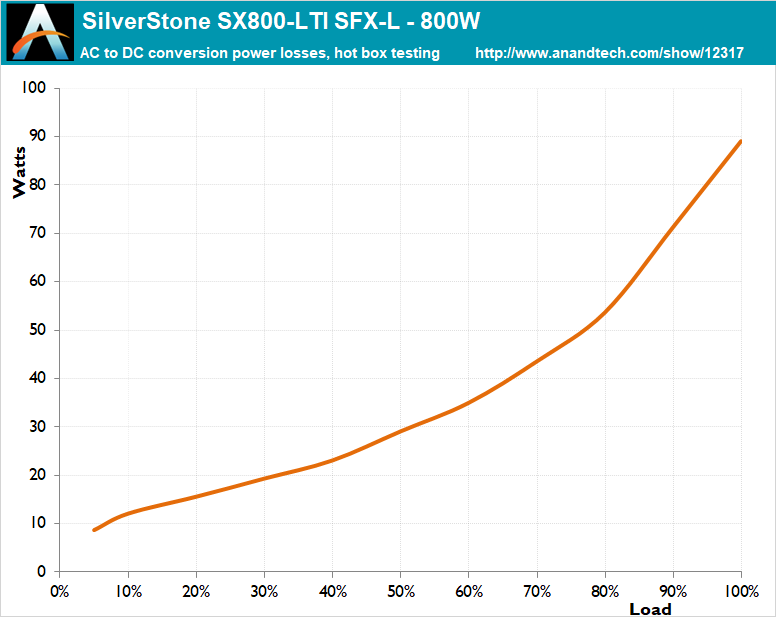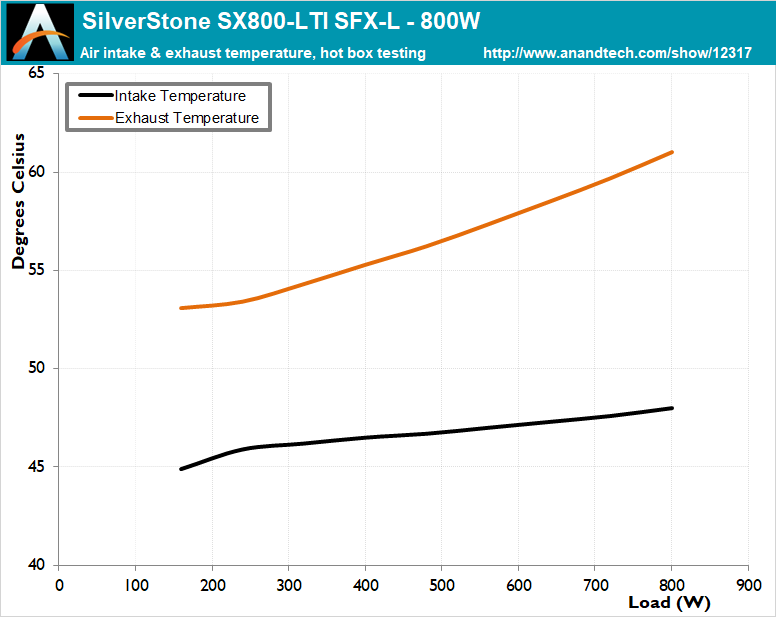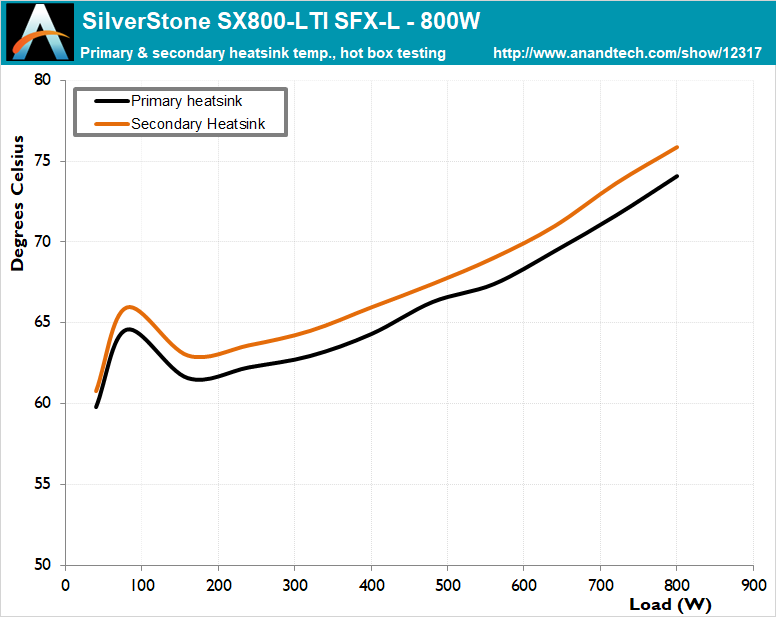The SilverStone SX800-LTI SFX-L 800W PSU Review: Big PSU, Small Niche
by E. Fylladitakis on January 18, 2018 9:00 AM EST- Posted in
- Cases/Cooling/PSUs
- SilverStone
- SFX
- SFX-L
Hot Test Results
The electrical performance of the SilverStone SX800-LTI is not greatly improved over that of the slightly older SilverStone SX700-LPT, but there is a small improvement on the output power quality. Voltage ripple figures are adequate, with our instruments recording a maximum of 36 mV, 40 mV and 32 mV on the 12V, 5V and 3.3V lines respectively. The paradox here is that the main 12V line seems to be much better filtered than the minor 5V/3.3V lines, which seem to have been somewhat neglected, perhaps because the designer just could not find enough space for more filtering components. Voltage regulation is good, with the 12V line maintaining a regulation of 2.2%. The 3.3V/5V lines are falling slightly behind, with the regulation at about 2.4%.
| Main Output | ||||||||
| Load (Watts) | 162.8 W | 404.87 W | 603.21 W | 796.4 W | ||||
| Load (Percent) | 20.35% | 50.61% | 75.4% | 99.55% | ||||
| Amperes | Volts | Amperes | Volts | Amperes | Volts | Amperes | Volts | |
| 3.3 V | 1.5 | 3.41 | 3.74 | 3.39 | 5.61 | 3.34 | 7.48 | 3.33 |
| 5 V | 1.4 | 5.1 | 3.51 | 5.07 | 5.26 | 5.03 | 7.01 | 4.98 |
| 12 V | 12.34 | 12.2 | 30.84 | 12.14 | 46.27 | 12.06 | 61.69 | 11.94 |
| Line | Regulation (20% to 100% load) |
Voltage Ripple (mV) | |||||
| 20% Load | 50% Load | 75% Load | 100% Load | CL1 12V |
CL2 3.3V + 5V |
||
| 3.3V | 2.6% | 22 | 24 | 26 | 32 | 16 | 26 |
| 5V | 2.4% | 20 | 30 | 32 | 40 | 18 | 26 |
| 12V | 2.2% | 16 | 22 | 30 | 36 | 36 | 22 |
Although the SX800-LTI is rated for operation up to 40°C, the unit had little trouble operating inside our hotbox. Naturally, the energy conversion efficiency took a measurable hit and the average efficiency across the nominal load range dropped down to 91.6%. The reduction of the unit’s efficiency is somewhat greater at higher loads, suggesting that the active components are slightly stressed by the high ambient temperatures.
The internal temperatures of the SX800-LTI, while it was operating in our hotbox, were surprisingly low. PSUs usually reach temperatures exceeding 80°C under these operating conditions, but the SilverStone SX800-LTI hardly reached up to 75°C under maximum load. This time the cooling fan started even sooner, when a load just higher than 120 Watts. The thermal control of this unit is very aggressive, probably because SilverStone did not want to risk reducing its reliability over better acoustics performance.
Under these high temperature conditions, the cooling fan of the SX800-LTI not only starts sooner but also immediately increases its speed to audible levels. Inside the hot box, the PSU is louder with a load of just 200 Watts than with a load of 550 Watts in room temperature. As the load increases, the speed of the fan constantly increases as well, reaching its maximum possible speed when the load exceeds 700 Watts. Thankfully our hotbox test is one of extremes and that - outside of poorly ventilated cabinets - few home users have environments this warm, as the sound pressure levels with a load above 500 Watts under these conditions would be practically intolerable for home users.















25 Comments
View All Comments
masteraleph - Friday, January 19, 2018 - link
1) It’s not large, but there is an enthusiast SFF market. ASRock is doing an mATX threadripper board and has an mITX x299 board, and there’s a lot of talk about bifurcation in the enthusiast sff community right now.2) SilverStone is working on a completely passive SFX-L psu at 400w using this psu as the base.
cbm80 - Friday, January 19, 2018 - link
Whatever happened to nice PSU cables? 10 years ago even cheap PSUs used beautifully sleeved cables, now even pricey PSUs have downgraded to this ribbon crap.meacupla - Saturday, January 20, 2018 - link
Ribbon cables are easier to work with, especially in tight places.Bundle sleeved cables add a lot of bulk to the cable ends and are unsuitable for SFF.
sharath.naik - Monday, February 26, 2018 - link
I have to correct the final conclusion in the article. I have this psu driving, a dual socket motherboard, 2 xeon v4 18 cores. 8 memory slots , with gtx 1080t. All in core g3 sfx case with additional holes drilled for eatx motherboard. In short, you can use a splitter for the 8 pin cpu cable to run dual socket motherboard.Ninjawithagun - Thursday, November 12, 2020 - link
And now, two years later, this PSU is the perfect solution for powering my mini-ITX gaming system inside the small form factor Nano S case. I'm running a 9900K, 16GB 4233Mhz DDR4, Samsung 950 Pro NVMe SSD, and EVGA RTX3080 FTW3 Ultra. The RTX3080 alone uses 450W (thanks to EVGA's latest BIOS update), so if anything I'm thinking I might actually have to upgrade the power supply if I so choose to overclock the CPU. Needless to say, no other SFX-L power supply is available today that can do what the Silverstone LTi could do two years ago ;-)